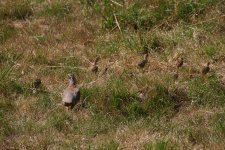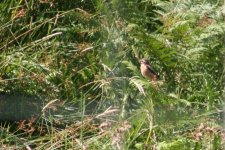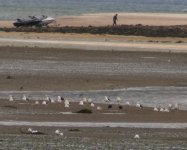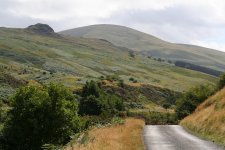A very tough haul up from Bamburgh on my bike to Harthope Valley yesterday.... but well worth it. A strong headwind all the way up from the coast made for difficult cycling conditions, and far-from-ideal birding conditions. But, nevertheless, one target species seen (and one heard!) and a few other surprises too.
Parked up in the dunes car park at Bamburgh, but didn't manage to get down to Stag Rock as hoped (having to repair a puncture before I set off put me behind schedule!). However, a quick scan of the sea only revealed a small group of eider just offshore. But the dunes were full of birdlife, with plenty of goldfinch and linnet, and a single whitethroat singing away, and briefly a grasshopper warbler reeling from the undergrowth (but not seen).
Over to Budle Bay, with the tide well out, and plenty of birds on the mud-flats. The biggest surprise was the presence of a spoonbill huddled in with a flock of gulls (great black-backed, herring and lesser black-backed). But there were also a few whimbrel, a pair of black-tailed godwit, curlew, oystercatcher and redshank among the waders. Some smaller waders too, but too far away for me to be able to identify! Also present were a large number of shelduck spread across the mud, and a group of mute swans including a couple of large cygnets. A pair of linnet and a pied wagtail foraged from a tree stump at the far end of the bay.
Linnet were the most frequently encountered bird seen en route to Wooler, with perhaps 25-30 seen along the road over from Belford to Wooler, with several yellowhammer too. Also, a flock of around 100 common gull on Belford Moor, and a family group of goldcrest seen at the narrow bridge over the River Till (Hetton House?).
Finally, to Harthope Valley. First birds seen were, again, several linnet feeding near the National Park sign, with a large group of swallows flying in and out of the stables nearby (at the top of the most ridiculously steep hill to try to cycle up!). Down into the valley, over the bridge, my first red-legged partridge of the day - an adult and 6 or 7 chicks with yet more linnet and yellowhammer, and a grey heron in the fields. A slow ride up the valley from there then added one of the day's target birds - a small bird perched on the fence ahead of me flew into the gorse and ferns before I could identify it, but I lay down in the grass for while, and eventually out came a pair of whinchat. Woohoo! I had good views for 10-15 minutes before a passing Northumberland National Park van scared them off, not to return. Shortly before the cattle grid, I had my first redpoll of the day, 4 birds chirping and trilling above me before landing on bushes next to the road (and I must say, what truly stunning birds they are in summer plumage). Also, chaffinch and woodpigeon on the small wooded island. As the valley opened out, a large number of sand martin zinged about above the river and in and out of their nest holes in the river banks. Further up the valley, a jay and a sparrowhawk flew over, and the distant calls of red grouse could be heard (but none seen), and just past Langleeford farm, 2 adult and 2 juvenile pied wagtail were flycatching, and lots more redpoll were twittering above the trees.
Finally gave up about half a mile after Langleeford as the track got too steep and stony, and wind was getting stronger and stronger, so headed back down the valley. Had a short wander up Hawsen Burn, but the ferns were too dense to get too far (and I was too knackered to be honest), but flushed a grey partridge and another jay flew over, but that was it.
One final sighting has me puzzled, however. Near to the wooded island not far up the valley, a very large pale blue and black dragonfly flew over, hovering above the river for a few seconds. The only species I can find in my insect guide that bares any resemblance is the emperor dragonfly, but my guide says it is a southern species and it's found only by still water, so in habitat terms it's all wrong. Any suggestions?








